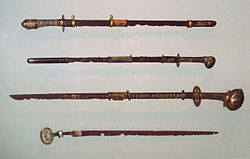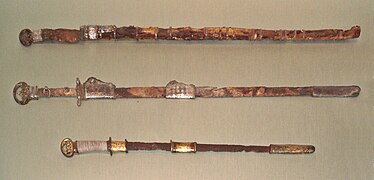Chokutō

The chokutō (直刀, "straight sword") is a straight, single-edged Japanese sword that was produced prior to the 9th century. Its basic style is likely derived from similar swords of ancient China.[1][2] Chokutō were used on foot for stabbing or slashing and were worn hung from the waist.[3][4][5] Until the Heian period such swords were called tachi (大刀), which should not be confused with tachi written as 太刀 referring to curved swords.[6]
History
The production of swords in Japan is divided into specific time periods:[7]
- Jōkotō (ancient swords, until around 900 C.E.)
- Kotō (old swords from around 900–1596)
- Shintō (new swords 1596–1780)
- Shinshintō (new new swords 1781–1876)
- Gendaitō (modern or contemporary swords 1876–present)
The chokutō was among the earliest types of sword to be forged in Japan, though its basic style and forging techniques probably originated in ancient China. From there, chokutō was brought to Japan by way of Korea in the 3rd century.[8][9] It was created before the development of differential tempering in Japanese swordsmithing. Chokutō typically come in hira-zukuri and kiriha-zukuri tsukurikomi (blade styles) which make them very distinct from later tachi and katana which rarely use these forms. Swords of this period are classified as jōkotō and are often referred to in distinction from Japanese swords.[7]
Chokutō as a weapon died out by the middle of the Heian period, in the 10th century. And as a weapon, it was completely replaced by the Japanese sword, which is known today for its deep and graceful curves. The first sword with this curve was called Kenukigata-tachi (ja:毛抜形太刀), which was made by improving Warabitetō (ja:蕨手刀) used by Emishi in Tohoku region.[10][11] And Kenukigata-tachi evolved into tachi, which became the mainstream of Japanese swords for a long time.[12]
In today's Japan, straight swords made with the techniques after tachi, which have nothing to do with the historical chokutō, are also collectively called chokutō, and these are sometimes used in traditional ceremonies.
Gallery
-
Shitennō-ji Shichiseiken, single-edged straight sword, Asuka period
-
Hilts of Japanese straight swords, Kofun period, 6-7th century, Met Museum.
-
Two Chinese swords (top) of the Sui Dynasty. Bottom: Japanese sword with scabbard, Kofun period, 6th century, Met Museum.
-
Sword hilts, end of the Kofun period, Japan, 6th century. Musée Guimet.
See also
References
- ^ "Katana:The Samurai Sword",Stephen Turnbull,2010,P.16
- ^ The connoisseur's book of Japanese swords, Kōkan Nagayama, Kodansha International, Mar 30 1998, P.12
- ^ The Japanese sword, Kanzan Satō, Kodansha International, May 30, 1983 P.28 "Katana:The Samurai Sword",Stephen Turnbull,2010,P.16
- ^ The connoisseur's book of Japanese swords, Kōkan Nagayama, Kodansha International, Mar 30 1998, P.12
- ^ The Japanese sword, Kanzan Satō, Kodansha International, May 30, 1983 P.28
- ^ "太刀・大刀". Daijirin at kotobank.jp (in Japanese). Retrieved July 22, 2015.
- ^ a b Transition of kotō, shintō, shinshintō, and gendaitō. Nagoya Japanese Sword Museum Touken World
- ^ "The Craft of the Japanese Sword",Leon Kapp,1987,P.20
- ^ "Katana:The Samurai Sword",Stephen Turnbull,2010,P.16
- ^ Shimomukai, Tatsuhiko (30 June 2000). The Review of the Study of History : Shigaku Kenkyu. 広島史学研究会.
- ^ John T. Kuehn (15 January 2014). A Military History of Japan: From the Age of the Samurai to the 21st Century. Praeger. p. 34. ISBN 978-1-59228-720-8.
- ^ 歴史人 September 2020. p.6 pp.36-37. ASIN B08DGRWN98




